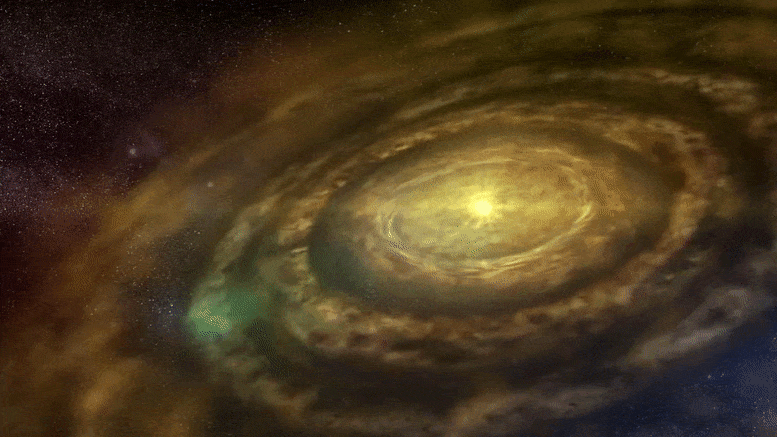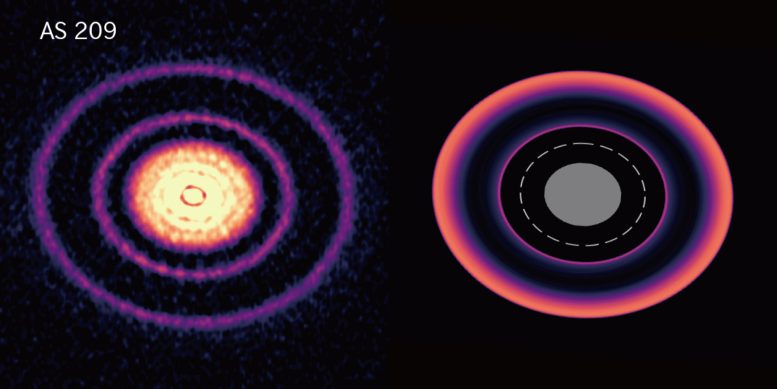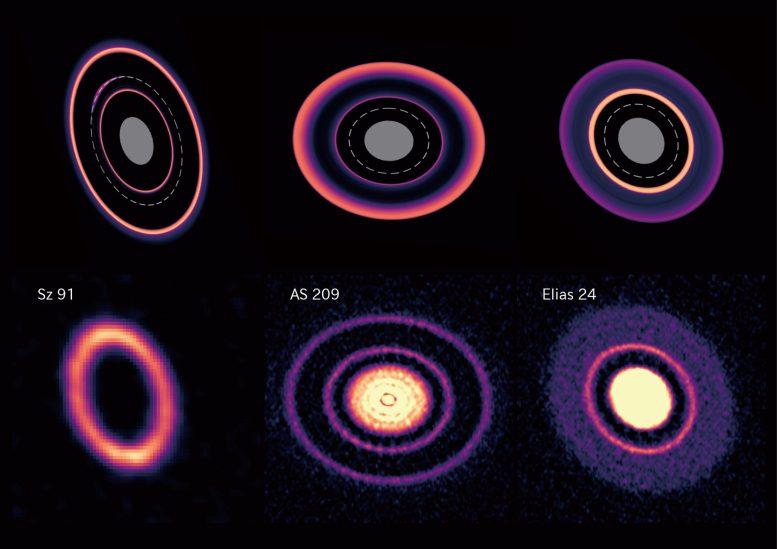New Supercomputer Simulations Provide Clue to Missing Planets Mystery
By NATIONAL INSTITUTES OF NATURAL SCIENCES NOVEMBER 14, 2021

Forming planets are one possible explanation for the rings and gaps observed in disks of gas and dust around young stars. But this theory has trouble explaining why it is rare to find planets associated with rings. New supercomputer simulations show that after creating a ring, a planet can move away and leave the ring behind. Not only does this bolster the planet theory for ring formation, the simulations show that a migrating planet can produce a variety of patterns matching those actually observed in disks.
A protoplanetary disk as observed by ALMA (left), and a protoplanetary disk during planetary migration, as obtained from the ATERUI II simulation (right). The dashed line in the simulation represents the orbit of a planet, and the gray area indicates a region not covered by the computational domain of the simulation. Credit: Kazuhiro Kanagawa, ALMA(ESO/NAOJ/NRAO)
Young stars are encircled by protoplanetary disks of gas and dust. One of the world’s most powerful radio telescope arrays, ALMA (Atacama Large Millimeter/submillimeter Array), has observed a variety of patterns of denser and less dense rings and gaps in these protoplanetary disks. Gravitational effects from planets forming in the disk are one theory to explain these structures, but follow-up observations looking for planets near the rings have largely been unsuccessful.
In this research a team from Ibaraki University, Kogakuin University, and Tohoku University in Japan used the world’s most powerful supercomputer dedicated to astronomy, ATERUI II at the National Astronomical Observatory of Japan, to simulate the case of a planet moving away from its initial formation site. Their results showed that in a low viscosity disk, a ring formed at the initial location of a planet doesn’t move as the planet migrates inwards. The team identified three distinct phases. In Phase I, the initial ring remains intact as the planet moves inwards. In Phase II, the initial ring begins to deform and a second ring starts forming at the new location of the planet. In Phase III, the initial ring disappears and only the latter ring remains.
A comparison of the three phases of ring formation and deformation found in these simulations by ATERUI II (top) with real examples observed by ALMA (bottom). The dotted lines in the simulation represent the orbits of the planets, and the gray areas indicate regions not covered by the computational domain of the simulation. In the upper row, the simulated protoplanetary disks are shown from left to right at the start of planetary migration (Phase I), during planetary migration (Phase II), and at the end of planetary migration (Phase III). Credit: Kazuhiro Kanagawa, ALMA(ESO/NAOJ/NRAO)
These results help explain why planets are rarely observed near the outer rings, and the three phases identified in the simulations match well with the patterns observed in actual rings. Higher resolution observations from next-generation telescopes, which will be better able to search for planets close to the central star, will help determine how well these simulations match reality.
Reference: “Dust Rings as a Footprint of Planet Formation in a Protoplanetary Disk” by Kazuhiro D. Kanagawa, Takayuki Muto and Hidekazu Tanaka, 12 November 2021, The Astrophysical Journal.
from scitechdaily 14/11/2021


Δεν υπάρχουν σχόλια:
Δημοσίευση σχολίου